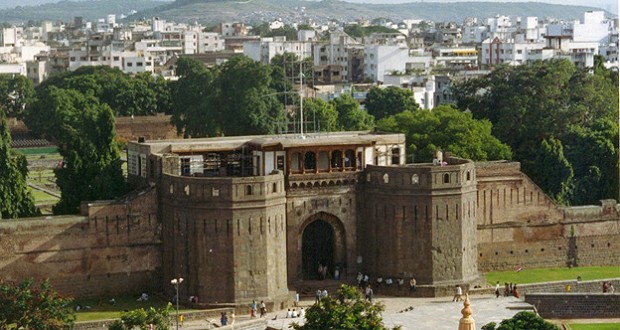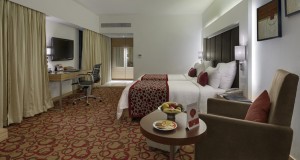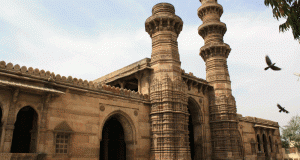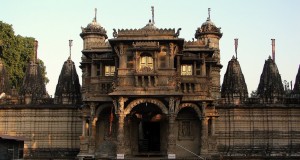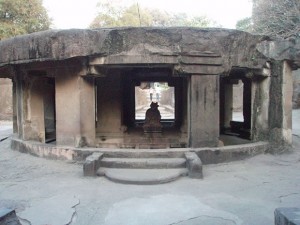 local shopping area just west of the centre, was built in 1886 and was originally named The Reay Market after Lord Reay, the then Governor of Bombay. Its architectural design—a number of covered galleries projecting out like spokes from a central structure (in this case a 27-m tower), served as a model for subsequent Indian markets built during the British period.The benign and universally revered Ganesh is regarded as one of the guardians of the city. The Ganapati Temple has grown from the original small temple built by Jijabai, Shahaji Bhonsle’s wife, in about 1636. The east-facing Omkareshvar Temple of Mahadeva was built between 1740-60 on the bank of the Mutha river in Shanwar Peth, and is surrounded by a high and massive fortified wall built in the Saracenic style. Panchaleshvara Temple, also called Pataleshwara, is an 8th century rock-cut cave temple in Shivajinagar on the Jangli Maharaj Road. It has huge pillars and a shrine of Shiva in the centre, with the Nandi in front under a circular canopy, all apparently hewn from a single rock. Parasnath Temple is in fact a group of four temples situated in Guruvar Peth, and is dedicated to Lord Parasnath, the 24th Jain saint. Here Jains of both sects, Svetarnbara and Digambara, have separate temples for worship. The newest of the four temples, dedicated to Risabder, was built in 1834. Other temples on Parvati Hill to the south-east of Pune include the temple of Parvati and Devadevasnvara built in 1749. Additional structures were built by successive Peshwas, including an unfinished large multi-storeyed palace by Bajirao II, the last Peshwa, which was destroyed by lightning in 1816.
local shopping area just west of the centre, was built in 1886 and was originally named The Reay Market after Lord Reay, the then Governor of Bombay. Its architectural design—a number of covered galleries projecting out like spokes from a central structure (in this case a 27-m tower), served as a model for subsequent Indian markets built during the British period.The benign and universally revered Ganesh is regarded as one of the guardians of the city. The Ganapati Temple has grown from the original small temple built by Jijabai, Shahaji Bhonsle’s wife, in about 1636. The east-facing Omkareshvar Temple of Mahadeva was built between 1740-60 on the bank of the Mutha river in Shanwar Peth, and is surrounded by a high and massive fortified wall built in the Saracenic style. Panchaleshvara Temple, also called Pataleshwara, is an 8th century rock-cut cave temple in Shivajinagar on the Jangli Maharaj Road. It has huge pillars and a shrine of Shiva in the centre, with the Nandi in front under a circular canopy, all apparently hewn from a single rock. Parasnath Temple is in fact a group of four temples situated in Guruvar Peth, and is dedicated to Lord Parasnath, the 24th Jain saint. Here Jains of both sects, Svetarnbara and Digambara, have separate temples for worship. The newest of the four temples, dedicated to Risabder, was built in 1834. Other temples on Parvati Hill to the south-east of Pune include the temple of Parvati and Devadevasnvara built in 1749. Additional structures were built by successive Peshwas, including an unfinished large multi-storeyed palace by Bajirao II, the last Peshwa, which was destroyed by lightning in 1816.
Shanwarwada Palace of the Peshwas was built in 1736. Located in the old city near the Mutta river and enclosed by massive walls, this fortress-like structure was destroyed in a fire in 1827. Now a garden stands in its former place with small signs indicating where the various structures stood. The Archaeological Department undertook the task of excavating the whole site, and the foundations, courtyards and other structures give I an indication of the splendour of the palace. From the 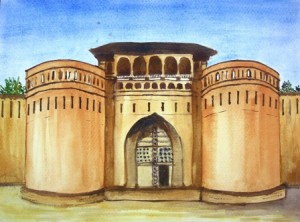 remains of the several fountains, particularly the huge lotus-shaped fountain with over a hundred pipe outlets, one can visualise the magnificent spectacle they must have made when operative. The best view of the whole enclosure inside can be obtained from the balcony of the Nagarkhana. The Raja Kelkar Museum in Shukrawar Peth houses various historical records and relics bearing on Maratha history. Of particular interest are the recreated rooms of the erstwhile Peshwas’ Palace, notably the bedroom of Peshwa Bajirao I and his mistress Mastani. Open daily from 8.30 am-12.30 and 3pm-6.30 pm.
remains of the several fountains, particularly the huge lotus-shaped fountain with over a hundred pipe outlets, one can visualise the magnificent spectacle they must have made when operative. The best view of the whole enclosure inside can be obtained from the balcony of the Nagarkhana. The Raja Kelkar Museum in Shukrawar Peth houses various historical records and relics bearing on Maratha history. Of particular interest are the recreated rooms of the erstwhile Peshwas’ Palace, notably the bedroom of Peshwa Bajirao I and his mistress Mastani. Open daily from 8.30 am-12.30 and 3pm-6.30 pm.
Rajneesh Ashram is situated in Koregaon Park, an oasis amidst the urban sprawl of Pune, set in 4 acres of grounds containing all varieties of lush tropical plants. The late, controversial godman Bhagwan Rajneesh had his Indian headquarters here and this was the place he retired to after the problems in Oregon. Beyond the Fitzgerald Bridge on the road toward the airport is the Aga Khan’s Palace built in 1860 by HH Aga Khan III, the spiritual head of the Ismailiah Khoja Community. This palace was where Mahatma Gandhi, his wife Kasturba and his private secretary Mahadev Desai were kept imprisoned during the 1942 Quit India movement. Both Mahadev Desai and Kasturba Gandhi died here, and two marble samadhis have been built in the ground in their memory.

